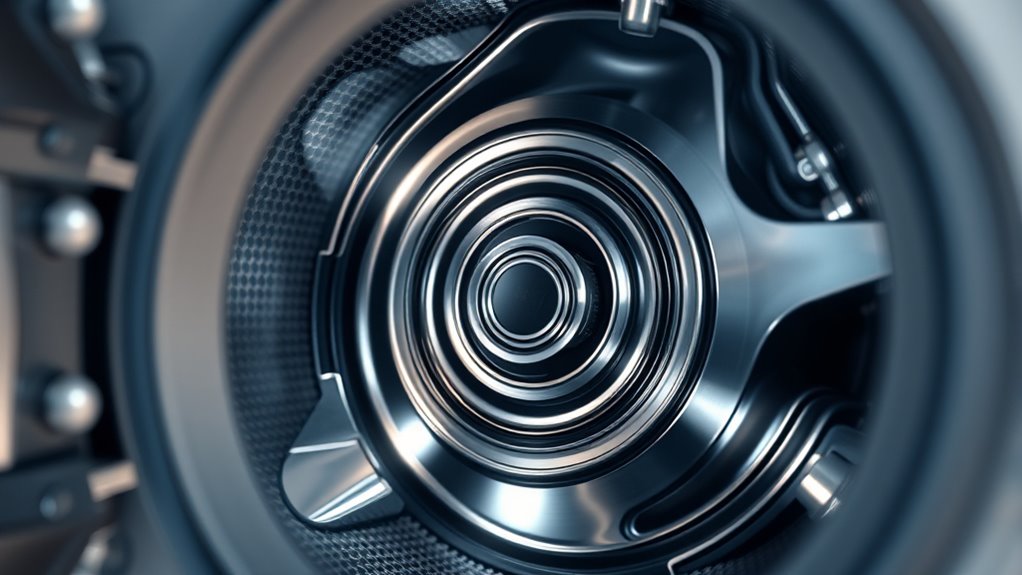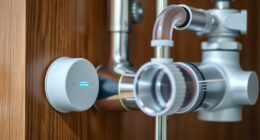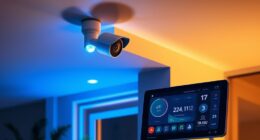In smart washers, motor control involves managing how the motor starts, runs, and stops efficiently, often through sensors and electronic components. You’ll find different motor types, like direct drive and brushless DC motors, which are optimized for performance and longevity. Control systems use feedback from sensors to adjust speed, load, and cycle times dynamically. Exploring further reveals how advanced algorithms and signal processing enhance energy savings, noise reduction, and overall reliability of your washer.
Key Takeaways
- Smart washers utilize various motor types like direct drive and brushless DC motors for efficient operation.
- Motor control systems include power supplies, drivers, and control interfaces to regulate speed, torque, and direction.
- Sensors and feedback mechanisms monitor parameters such as load, water level, and drum speed for adaptive control.
- Signal processing techniques filter noise and interpret sensor data to optimize motor performance and prevent faults.
- Proper calibration, component quality, and advanced algorithms enhance motor control reliability and energy efficiency.
Overview of Motor Control in Household Appliances
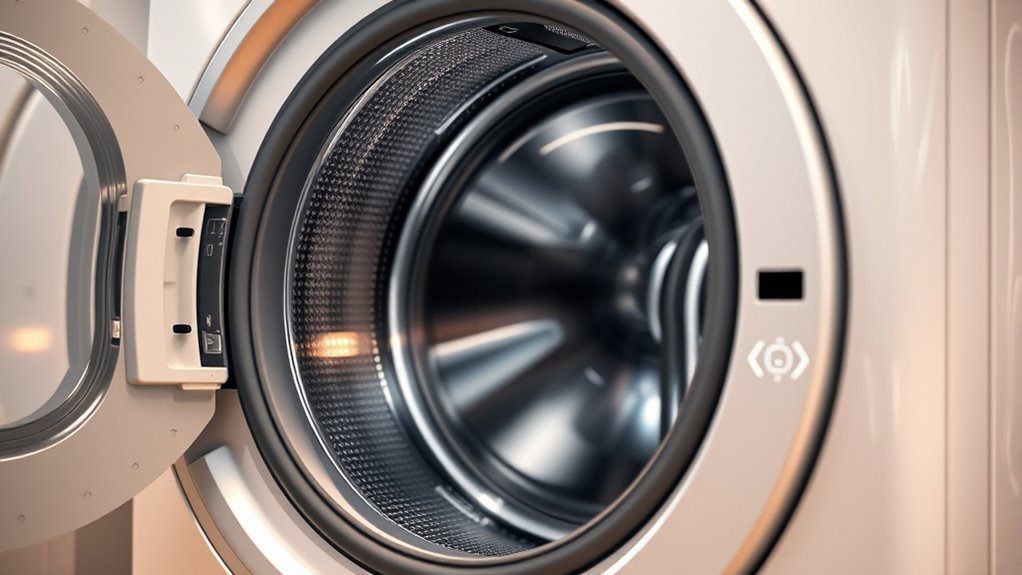
Motor control in household appliances plays a pivotal role in ensuring efficient and reliable operation. It manages how motors start, run, and stop, helping your appliances perform their functions smoothly. In washers, motor control systems regulate spin cycles, agitation, and water flow, making sure each process happens at the right time and speed. These systems use various sensors and electronic components to monitor conditions and adjust motor performance accordingly. Good motor control reduces energy consumption and minimizes wear and tear, extending the lifespan of your appliances. Additionally, energy efficiency is enhanced through precise motor control, which contributes to lower utility bills. By precisely controlling motor functions, you experience fewer malfunctions and better overall performance. Incorporating AI-driven control strategies is also becoming more common, further optimizing appliance performance and reliability. Understanding motor control technologies helps you appreciate the complexity behind household appliance operation and their ability to operate efficiently over time. Moreover, advancements in motor control algorithms are enabling smarter, more adaptive systems that can respond dynamically to changing conditions and user needs. Proper calibration and maintenance of motor control components are essential to sustain optimal operation and prevent potential failures.
Types of Motors Used in Smart Washers
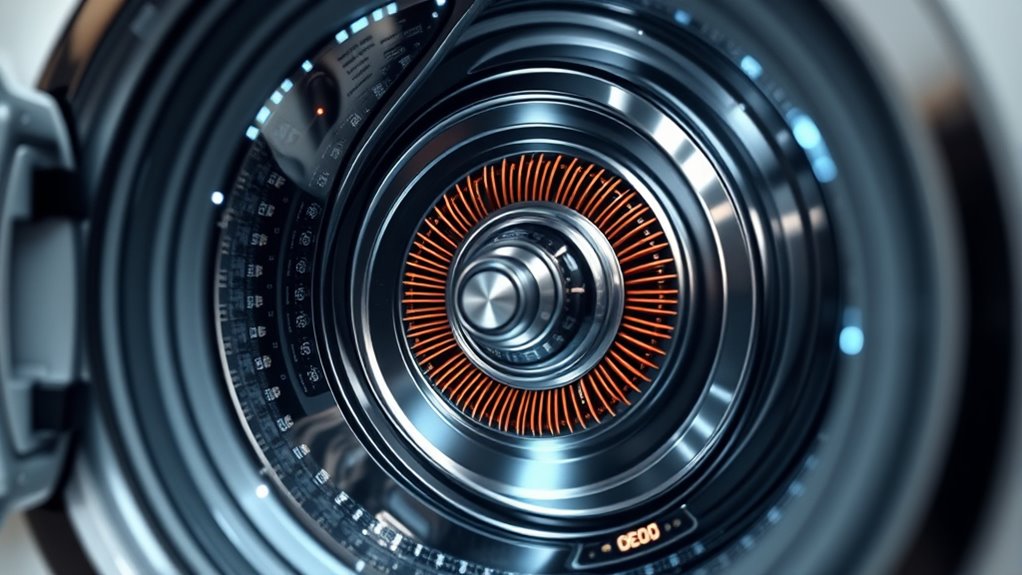
Smart washers typically use different motor types to optimize performance. You’ll find direct drive motors, which connect directly to the drum, and brushless DC motors, known for their efficiency and longevity. Understanding these options helps you appreciate how your washer operates smoothly and reliably. Additionally, selecting a motor with high-quality components can significantly improve the durability and consistent performance of your appliance. Incorporating insights from sound healing science reveals how precise vibrations can enhance motor efficiency and reduce operational noise, leading to a better user experience. Moreover, choosing a motor with proper maintenance can extend its lifespan and ensure optimal functioning over time. Furthermore, many premium washers utilize vetted technology to ensure reliability and performance under various conditions. Keeping abreast of security in payment processing practices can also help manufacturers protect customer data and maintain trust.
Direct Drive Motors
Because they eliminate the need for belts and pulleys, direct drive motors are increasingly popular in smart washers. They connect directly to the drum, reducing mechanical parts that can wear out or cause noise. This design offers several key benefits:
- Improved efficiency due to fewer energy losses
- Reduced maintenance needs
- Quieter operation
- Precise control over drum speed
- Enhanced durability and reliability
With direct drive motors, you get smoother performance and longer-lasting components. They also enable smarter features like variable speed control and adaptive wash cycles, making your laundry experience more efficient. Since there are no belts or pulleys to slip or break, your washer stays in top shape longer and operates more quietly. Overall, direct drive motors contribute markedly to the advanced functionality of modern smart washers.
Brushless DC Motors
Building on the advantages of direct drive motors, many modern washers now incorporate brushless DC (BLDC) motors to enhance performance further. These motors use electronic commutation instead of brushes, reducing wear and maintenance. You’ll find BLDC motors deliver higher efficiency, quieter operation, and better speed control, making your washer more reliable and energy-efficient. They’re lightweight and compact, allowing for more flexible design options. Because they operate without brushes, they generate less heat and have a longer lifespan. You benefit from smoother and more precise control over the drum’s rotation, which improves wash quality. Additionally, remote hackathons provide opportunities to collaborate with experts and share innovative ideas, which can inspire new features and improvements in smart washer technology. These collaborative events often focus on technological advancements, driving innovation and development in appliance engineering. Overall, BLDC motors are a crucial upgrade, offering durability and performance that meet the demands of modern smart washers. Furthermore, understanding motor types can help in selecting the most suitable motor for specific applications, ensuring optimal efficiency and longevity. Recognizing the importance of efficient motor operation can lead to better energy savings and reduced environmental impact in appliance design.
Principles of Electric Motor Operation
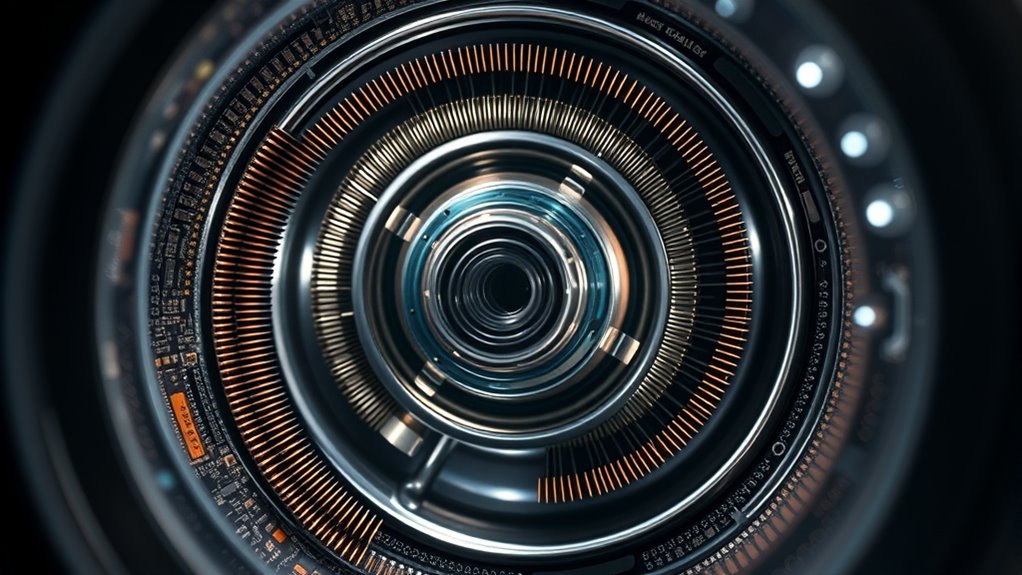
Electric motors operate by converting electrical energy into mechanical motion through electromagnetic principles. When current flows through the motor’s coils, it creates a magnetic field that interacts with permanent magnets or other coils, producing force. This force causes the rotor to turn, driving the motor’s shaft. To understand how it works, consider these key points:
- Electricity creates magnetic fields in the stator and rotor
- Interaction of magnetic fields produces torque
- Commutation switches current direction for continuous rotation
- The motor’s design determines speed and torque capabilities
- Efficient operation depends on minimizing energy losses
- Support hours may vary by region and are available through PlayStation Support Hours resources for troubleshooting. Additionally, proper maintenance and cooling systems are essential to ensure optimal performance and longevity of the motor.
Components of a Motor Control System
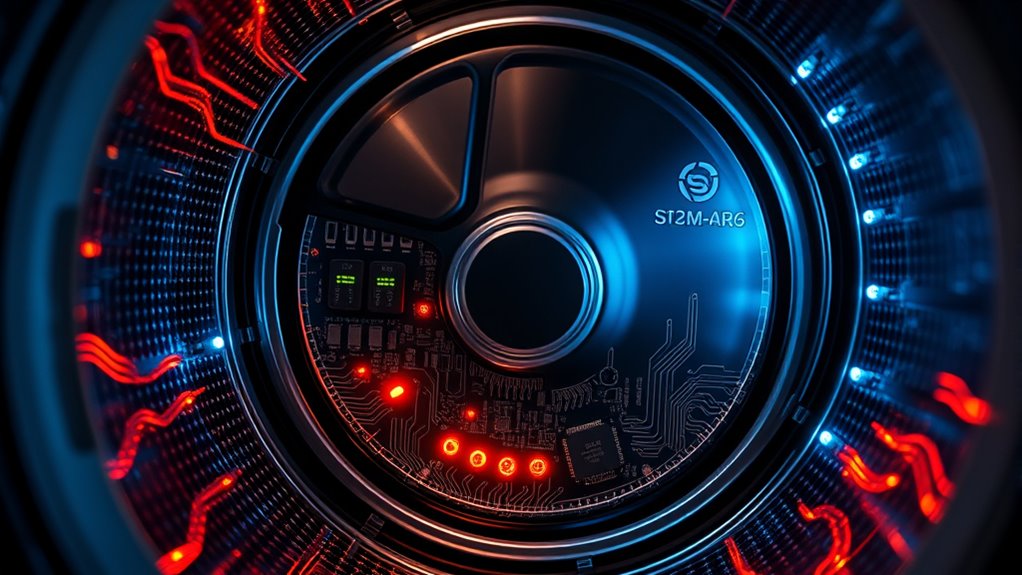
To control the motor effectively, you need to understand its key components. These include the power supply units that provide energy, motor driver modules that manage motor operation, and control interface options that allow user interaction. Each element plays an essential role in ensuring smooth and precise motor performance in your smart washer. Additionally, incorporating performance optimization techniques can improve overall efficiency and longevity of the motor system.
Power Supply Units
Power supply units are vital components of a motor control system in smart washers, providing the necessary electrical energy for operation. They convert AC power from your home into usable DC voltage or specific AC signals for the motor and control circuitry. A reliable power supply guarantees consistent performance and prevents damage due to voltage fluctuations. When selecting a power supply, consider factors like voltage stability, current capacity, and noise filtering. Good power supplies feature:
- Overvoltage protection
- Short-circuit protection
- Voltage regulation
- Power filtering
- Compact design
These features help maintain smooth operation and extend the lifespan of your washer’s motor system. Making sure your power supply is appropriately rated and protected is vital for the overall efficiency and safety of your smart washer’s motor control system.
Motor Driver Modules
Motor driver modules are essential components that control the operation of the washer’s motor by regulating current flow and voltage. They serve as the bridge between your washer’s control system and the motor, translating signals into appropriate power levels. By adjusting the current, driver modules determine the motor’s speed, torque, and direction, ensuring smooth operation during washing cycles. They protect the motor from overloads and electrical faults, enhancing durability. Most modules use transistors or MOSFETs to switch power efficiently, reducing heat and energy loss. You’ll find these modules integrated with sensors and microcontrollers to allow precise control of motor functions. Proper selection and integration of driver modules are critical for ideal washer performance, energy efficiency, and reliable operation throughout its lifespan.
Control Interface Options
Control interface options are the essential link between the washer’s main control system and the motor driver modules, enabling precise regulation of motor functions. Choosing the right interface guarantees accurate communication and smooth operation. Common options include digital signals like PWM, analog signals, and serial communication protocols such as CAN or UART. These interfaces translate control commands into motor actions, providing real-time feedback and adjustments. When selecting an interface, consider compatibility, response time, noise immunity, and ease of integration. The right control interface simplifies troubleshooting and enhances system reliability.
- Compatibility with existing control systems
- Speed and response time
- Noise immunity and interference resistance
- Ease of integration and setup
- Support for feedback and diagnostics
Role of Sensors and Feedback Mechanisms
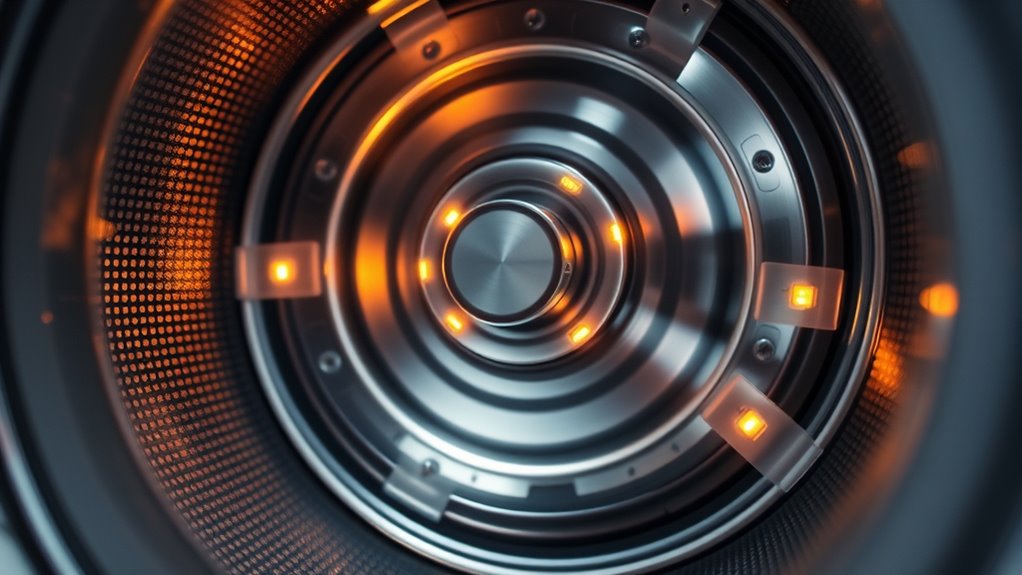
Sensors and feedback mechanisms are essential components that enable smart washers to adapt to different load conditions and maximize performance. They continuously monitor parameters like water level, load weight, and drum speed, providing real-time data to the control system. This information allows you to adjust motor speed, torque, and cycle duration precisely, preventing issues like overloading or inefficient washing. For example, load sensors detect the weight of laundry and help determine the appropriate water level and cycle time. Speed sensors track drum rotation, ensuring smooth operation and preventing damage. Feedback mechanisms act as the washer’s sensory system, ensuring maximum performance by constantly relaying information. Without these sensors and feedback loops, the washer wouldn’t be able to respond dynamically to varying loads, compromising efficiency and washing quality.
Control Algorithms and Signal Processing
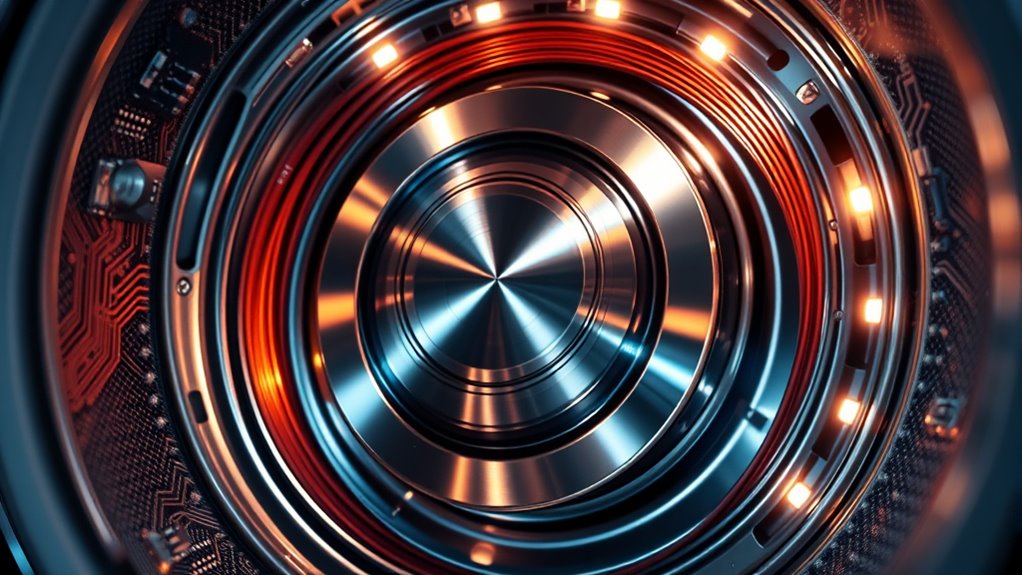
Effective operation of smart washers relies heavily on sophisticated control algorithms and signal processing techniques that interpret sensor data and determine ideal actions. These algorithms analyze inputs like load weight, water level, and motor speed, enabling precise adjustments. They guarantee optimal wash cycles, prevent motor overloads, and improve cycle times. Signal processing filters noise, detects anomalies, and enhances data accuracy for better control. Key components include:
Smart washers use advanced algorithms and signal processing to optimize performance and reliability.
- Real-time data filtering for cleaner signals
- Adaptive algorithms that learn from usage patterns
- PID controllers to maintain steady motor speed
- Fault detection to preemptively identify issues
- Feedback loops to continuously optimize performance
Energy Efficiency and Noise Reduction Techniques
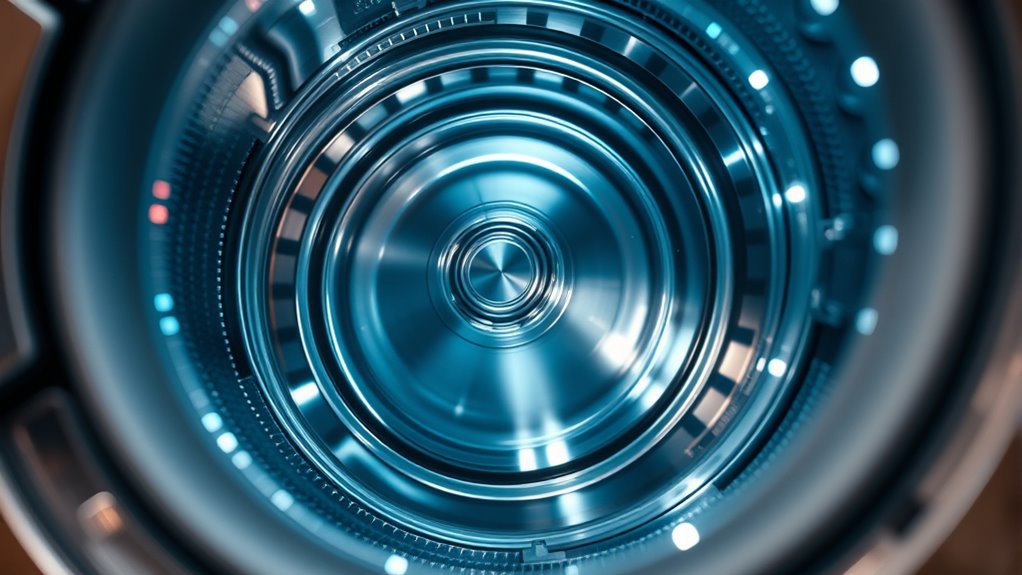
To enhance both energy efficiency and noise reduction, smart washers employ advanced motor control techniques and innovative design features. Variable frequency drives adjust motor speed based on load, conserving energy and minimizing unnecessary power use. Soft-start mechanisms reduce mechanical stress and limit noise during startup, making operation quieter. Precise motor control algorithms optimize torque and speed, preventing energy waste and reducing vibrations. Insulation and dampening materials are strategically incorporated into the design to absorb sound and minimize noise transmission. Additionally, using high-efficiency motors with improved magnetic and electrical properties guarantees less energy loss. These combined approaches allow smart washers to operate quietly while consuming less power, providing a more sustainable and comfortable user experience.
Future Trends in Motor Control Technology
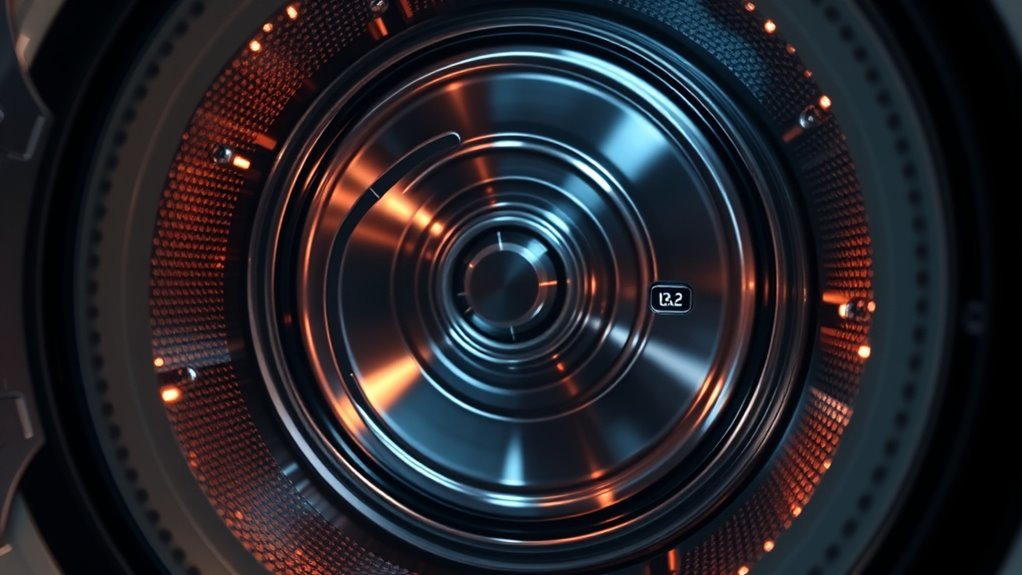
As technology advances, future motor control systems in smart washers will become even more intelligent and adaptive. Expect systems to incorporate AI and machine learning for real-time optimization, improving performance and energy use. Enhanced sensors will provide more detailed data, enabling precise adjustments during operation. Additionally, motor controls will become more compact, reducing size and complexity. You might see greater integration with IoT platforms, allowing remote monitoring and control. Innovations such as self-diagnosing motors will improve maintenance and longevity. To summarize, future trends include:
- Smarter, AI-driven control algorithms
- Advanced sensor integration
- IoT connectivity for remote management
- Compact, efficient motor designs
- Self-diagnostic and predictive maintenance features
These advancements will make smart washers more efficient, reliable, and user-friendly.
Frequently Asked Questions
How Do Motor Control Systems Adapt to Different Wash Load Sizes?
When you load a washer with different sizes, the motor control system adjusts automatically. It senses the load weight and distribution through sensors, then modifies motor speed, torque, and cycle duration accordingly. This guarantees ideal washing performance and energy efficiency. You don’t need to do anything; the system dynamically adapts in real-time, providing a tailored wash cycle that protects your clothes and conserves resources.
What Safety Features Are Integrated Into Smart Washer Motor Controls?
Imagine your smart washer’s motor control system as a vigilant guardian, always on watch. It integrates safety features like overload protection, which acts like a sturdy shield, preventing damage from excessive loads. Temperature sensors serve as vigilant sentinels, ensuring the motor doesn’t overheat. Emergency shutoff functions act as a trusted alarm, halting operation if any fault arises. These features work together, safeguarding your appliance and ensuring safe, reliable operation.
How Do Motor Control Systems Diagnose Faults or Malfunctions?
When your smart washer detects a fault or malfunction, its motor control system actively monitors performance through sensors and software diagnostics. It analyzes data such as current, voltage, and motor speed to identify irregularities. If a problem arises, the system quickly pinpoints the issue, often displaying an error code or alert. This proactive approach helps you troubleshoot effectively and guarantees safe, dependable operation of your washer.
Can Motor Control Systems Be Remotely Monitored or Updated?
You might think it’s a tall order, but yes, motor control systems in smart washers can be remotely monitored and updated. With the right connectivity, like Wi-Fi or Bluetooth, you can keep an eye on performance, troubleshoot issues, and push updates from afar. It’s like having a mechanic in your pocket, making sure your washer runs smoothly without ever leaving the couch. Technology is truly a game-changer!
What Are the Common Challenges in Implementing Advanced Motor Controls?
When implementing advanced motor controls, you often face challenges like integrating complex hardware and software, guaranteeing system reliability, and managing compatibility with existing components. You need to address issues like precise calibration, real-time monitoring, and fault detection. Additionally, balancing cost and performance can be tricky, especially when upgrading older systems. Overcoming these hurdles requires careful planning, robust design, and ongoing testing to guarantee smooth operation and peak performance.
Conclusion
Imagine your smart washer as a skilled conductor, expertly guiding each spin and rinse with precision. Its motor control system acts like a finely tuned orchestra, responding seamlessly to sensors and signals. As technology advances, you’ll notice quieter, more energy-efficient cycles, whispering softly like a gentle breeze. With ongoing innovations, your laundry experience will become smoother, smarter, and more harmonious—turning routine washes into a symphony of efficiency and convenience.
